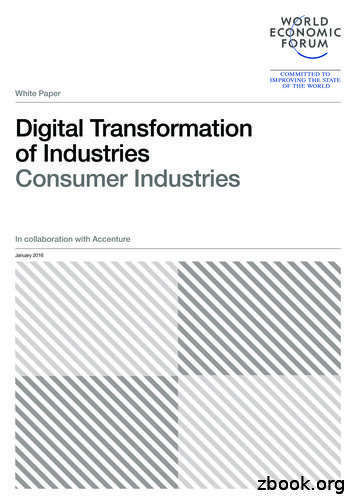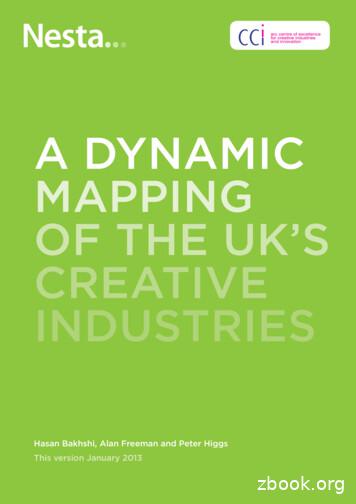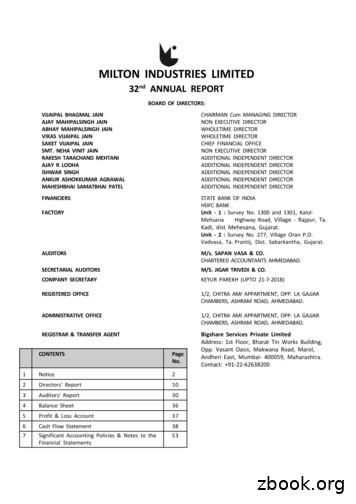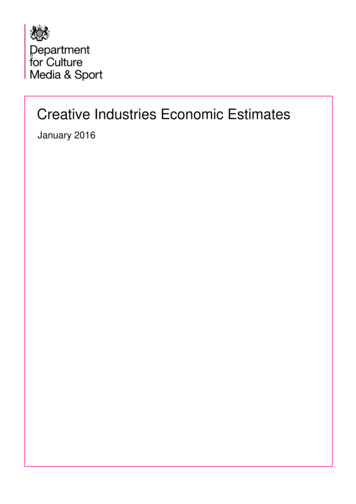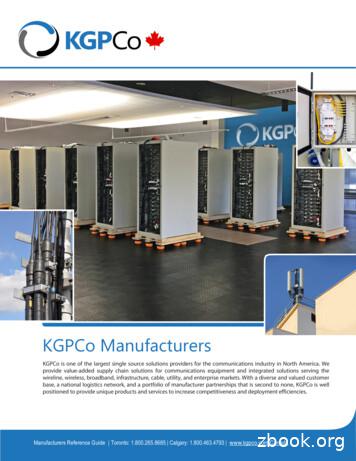Industries
IndustriesHave you ever given a thought to the fact that the notebook you use for writing has come to you after a longprocess of manufacturing. It started its life as part of atree. It was cut down and transported to the pulp mill.There the wood of the tree was processed and convertedinto wood pulp. The wood pulp was mixed with chemicalsand finally changed into paper by machines. This paperfound its way to the press where ink made from chemicalswas used to print the lines on the pages. The pages werethen bound in the form of a note book, packed and sent tothe market for sale. Finally, it reached your hands.Journey begins.paper made.recycle.ActivityTrace the journeyof your shirt froma cotton field toyour wardrobe.Secondary activities or manufacturing changeraw materials into products of more value to people. Asyou have seen pulp was changed into paper and paperinto a note book. These represent the two stages of themanufacturing process.The paper made from pulp and cloth made fromcotton have had value added to them at each stage of themanufacturing process. In this way the finished producthas more value and utility than the raw material that itis made from.Industry refers to an economic activity that isconcerned with production of goods, extraction ofminerals or the provision of services. Thus we have ironand steel industry (production of goods), coal miningindustry (extraction of coal) and tourism industry(service provider).ClassificationofIndustriesIndustries can be classified on the basis of raw materials,size and ownership.2020-21
Raw Materials: Industries may be agro based, mineralbased, marine based and forest based depending on thetype of raw materials they use. Agro based industriesuse plant and animal based products as their rawmaterials. Food processing, vegetable oil, cotton textile,dairy products and leather industries are examples ofagro-based industries. Mineral based industries areprimary industries that use mineral ores as their rawmaterials. The products of these industries feed otherindustries. Iron made from iron ore is the product ofmineral based industry. This is used as raw material forthe manufacture of a number of other products, suchas heavy machinery, building materials and railwaycoaches. Marine based industries use products from thesea and oceans as raw materials. Industries processingsea food or manufacturing fish oil are some examples.Forest based industries utilise forest produce as rawmaterials. The industries associated with forests are pulpand paper, pharmaceuticals, furniture and buildings.ActivityGive someexamples of agrobased industries.Size: It refers to the amount of capital invested,number of people employed and the volume of production.Based on size, industries can be classified into smallscale and large scale industries. Cottage orhousehold industries are a type of small scaleindustry where the products are manufacturedby hand, by the artisans. Basket weaving,pottery and other handicrafts are examplesof cottage industry. Small scale industriesuse lesser amount of capital and technologyas compared to large scale industries thatproduce large volumes of products. Investmentof capital is higher and the technology usedis superior in large scale industries. Silkweaving and food processing industries aresmall scale industries(Fig 5.1). Production ofFig 5.1: Stages in food processing ofautomobiles and heavy machinery are largeGorgon nut (makhana)scale industries.Ownership: Industries can be classified into privatesector, state owned or public sector, joint sector andcooperative sector. Private sector industries are ownedand operated by individuals or a group of individuals.The public sector industries are owned and operated bythe government, such as Hindustan Aeronautics LimitedIndustries2020-2149
Fig 5.2: Sudha dairy inCo-operative sectorand Steel Authority of India Limited. Joint sectorindustries are owned and operated by the stateand individuals or a group of individuals. MarutiUdyog Limited is an example of joint sectorindustry. Co-operative sector industries areowned and operated by the producers or suppliersof raw materials, workers or both. Anand MilkUnion Limited and Sudha Dairy are a successstories of a co-operative venture.Factors Affecting LocationFig 5.3: Locational factors for industriesofIndustriesThe factors affecting the locationof industries are the availability ofraw material, land, water, labour,power, capital, transport and market.Industries are situate d where some orall of these factors are easily available.Sometimes, the government providesincentives like subsidised power, lowertransport cost and other infrastructureso that industries may be located inbackward areas. Industrialisationoften leads to development and growthof towns and cities.Industrial SystemActivityFind out theinputs, outputsand processesinvolved in themanufacture of aleather shoe.An industrial system consists of inputs, processes andoutputs. The inputs are the raw materials, labour andcosts of land, transport, power and other infrastructure.The processes include a wide range of activities thatconvert the raw material into finished products. Theoutputs are the end product and the income earnedfrom it. In case of the textile industry the inputs may becotton, human labour, factory and transport cost. Theprocesses include ginning, spinning, weaving, dyeingand printing. The output is the shirt you wear.Industrial RegionsIndustrial regions emerge when a number of industrieslocate close to each other and share the benefits oftheir closeness. Major industrial regions of the worldare eastern North America, western and central Europe,eastern Europe and eastern Asia (Fig 5.4). Major50ResourcesandDevelopment2020-21
Fig 5.4: World’s Industrial Regionsindustrial regions tend to be located in the temperateareas, near sea ports and especially near coal fields.India has several industrial regions like MumbaiPune cluster, Bangalore-Tamil Nadu region, Hugli region,Ahmedabad-Baroda region, Chottanagpur industrial belt,Vishakhapatnam-Guntur belt, Gurgaon-Delhi-Meerutregion and the Kollam-Thiruvanathapuram industrialcluster.Industrial DisasterIn industries, accidents/disasters mainly occur due to technicalfailure or irresponsible handling of hazardous material.One of the worst industrial disasters of all time occurredin Bhopal on 3 December 1984 around 00:30 a.m. It wasa technological accident in which highly poisonous MethylIsocynate (MIC) gas along with Hydrogen Cyanide and otherreaction products leaked out of the pesticide factory of UnionCarbide. The official death toll was 3,598 in 1989. Thousands,who survived still suffer from one or many ailments like blindness,impaired immune system, gastrointestinal disorders etc.Union Carbide FactoryIndustries2020-2151
In another incident, on 23 December 2005, due to gas wellblowout in Gao Qiao, Chongging, China, 243 people died, 9,000 wereinjured and 64,000 were evacuated. Many people died because theywere unable to run after the explosion. Those who could not escapein time suffered burns to their eyes, skin and lungs from the gas.Risk Reduction Measures1.2.3.4.5.Densely populated residential areas should be separated faraway from the industrial areas.Rescue operationPeople staying in the vicinity of industries should be aware ofin Gao Qiaothe storage of toxins or hazardous substances and their possibleeffects in case if an accident occurs.Fire warning and fighting system should be improved.Storage capacity of toxic substances should be limited.Pollution dispersion qualities in the industries should beimproved.Distribution Of Major IndustriesDo you know?Emergingindustries are alsoknown as ‘SunriseIndustries’.Theseinclude Informationtechnology,Wellness,Hospitality andKnowledge.The world’s major industries are the iron and steelindustry, the textile industry and the informationtechnology industry. The iron and steel and textileindustry are the older industries while informationtechnology is an emerging industry.The countries in which iron and steel industry islocated are Germany, USA, China, Japan and Russia.Textile industry is concentrated in India, Hong Kong,South Korea, Japan and Taiwan. The major hubs ofInformation technology industry are the Silicon valleyof Central California and the Bangalore region of India.Iron and Steel IndustryGlossarySmeltingIt is the processin which metalsare extractedfrom their ores byheating beyondthe melting point52ResourcesandLike other industries iron and steel industry toocomprises various inputs, processes and outputs. Thisis a feeder industry whose products are used as rawmaterial for other industries.The inputs for the industry include raw materialssuch as iron ore, coal and limestone, along with labour,capital, site and other infrastructure. The process ofconverting iron ore into steel involves many stages.The raw material is put in the blast furnace where itundergoes smelting (Fig 5.6). It is then refined. Theoutput obtained is steel which may be used by otherindustries as raw material.Development2020-21
8 tonnes of coal 4 tonnes ofiron ore 1 tonne oflimestone 1 tonne ofsteelFig 5.5: Manufacturing of steelSteel is tough and it can easily be shaped, cut,or made into wire. Special alloys of steel can bemade by adding small amounts of other metalssuch as aluminium, nickel, and copper. Alloys givesteel unusual hardness, toughness, or ability toresist rust.Steel is often called the backbone of modernindustry. Almost everything we use is either madeof iron or steel or has been made with tools andmachinery of these metals. Ships, trains, trucks,and autos are made largely of steel. Even the safetypins and the needles you use are made from steel.Oil wells are drilled with steel machinery. Steelpipelines transport oil. Minerals are mined withsteel equipment. Farm machines are mostly steel.Large buildings have steel framework.Before 1800 A.D. iron and steel industry waslocated where raw materials, power supply and2: The best locationrunning water were easilyfrom 1800 to 1950available. Later the ideallocation for the industry wasnear coal fields and close tocanals and railways. After1950, iron and steel industrybegan to be located on largeareas of flat land near seaports. This is because by thistime steel works had becomevery large and iron ore hadto be imported from overseas(Fig 5.7).In India, iron and steelindustry has developed takingFig. 5.6: From iron ore to steelin a blast furnace1: The best locationbefore 18003: The best locationsince 1950Fig 5.7: The changing location of the iron andsteel industryIndustries2020-2153
Fig 5.8: World: Major Iron Ore Producing Areasadvantage of raw materials, cheap labour, transport andmarket. All the important steel producing centres such asBhilai, Durgapur, Burnpur, Jamshedpur, Rourkela, Bokaroare situated in a region that spreads over four states — WestBengal, Jharkhand, Odisha and Chhattisgarh. Bhadravatiand Vijay Nagar in Karnataka, Vishakhapatnam in AndhraPradesh, Salem in Tamil Nadu are other important steelcentres utilising local resources.JamshedpurBefore 1947, there was only one iron and steel plant in thecountry – Tata Iron and Steel Company Limited (TISCO). Itwas privately owned. After Independence, the governmenttook the initiative and set up several iron and steel plants.TISCO was started in 1907 at Sakchi, near the confluence ofthe rivers Subarnarekha and Kharkai in Jharkhand. Lateron Sakchi was renamed as Jamshedpur. Geographically,Jamshedpur is the most conveniently situated iron andsteel centre in the country.54ResourcesandDevelopment2020-21
SketchFig 5.9: Location of iron and steel industry in JamshedpurSakchi was chosen to set up the steel plant forseveral reasons. This place was only 32 km away fromKalimati station on the Bengal-Nagpur railway line. Itwas close to the iron ore, coal and manganese depositsas well as to Kolkata, which provided a large market.TISCO, gets coal from Jharia coalfields, and iron ore,limestone, dolomite and manganese from Odisha andChhattisgarh. The Kharkai and Subarnarekha riversensured sufficient water supply. Government initiativesprovided adequate capital for its later development.In Jamshedpur, several other industrial plants wereset up after TISCO. They produce chemicals, locomotiveparts, agricultural equipment, machinery, tinplate,cable and wire.Let’s doWith the help ofan atlas identifysome iron andsteel industries inIndia and marktheir location onan outline map ofIndia.The development of the iron and steel industryopened the doors to rapid industrial development inIndia. Almost all sectors of the Indian industry dependheavily on the iron and steel industry for their basicinfrastructure. The Indian iron and steel industryconsists of large integrated steel plants as well as miniIndustries2020-2155
steel mills. It also includes secondary producers, rollingmills and ancillary industries.Do you know?The names of GreatLakes are Superior,Huron, Ontario,Michigan and Erie.Lake Superior isthe largest of thesefive lakes. It lieshigher upstreamthan others.Pittsburgh : It is an important steel city of the UnitedStates of America. The steel industry at Pittsburghenjoys locational advantages. Some of the raw materialsuch as coal is available locally, while the iron ore comesfrom the iron mines at Minnesota, about 1500 km fromPittsburgh. Between these mines and Pittsburgh is oneof the world’s best routes for shipping ore cheaply – thefamous Great Lakes waterway. Trains carry the orefrom the Great Lakes to the Pittsburgh area. The Ohio,the Monogahela and Allegheny rivers provide adequatewater supply.Today, very few of the large steel mills are in Pittsburghitself. They are located in the valleys of the Monogahelaand Allegheny rivers above Pittsburgh and along theOhio River below it. Finished steel is transported to themarket by both land and water routes.The Pittsburgh area has many factories other thansteel mills. These use steel as their raw material to makemany different products such as railroad equipment,heavy machinery and rails.Cotton Textile IndustryWord OriginThe term ‘textile’is derived fromthe Latin wordtexere whichmeans to weave.Weaving cloth from yarn is an ancient art. Cotton,wool, silk, jute, flax have been used for making cloth.The textile industry can be divided on the basis of rawmaterials used in them. Fibres are the raw material oftextile industry. Fibres can be natural or man-made.Natural fibres are obtained from wool, silk, cotton, linenand jute. Man made fibres include nylon, polyester,acrylic and rayon.The cotton textile industry is one of the oldestindustries in the world. Till the industrial revolution inthe 18th century, cotton cloth was made using handspinning techniques (wheels) and looms. In 18th centurypower looms facilitated the development of cotton textileindustry, first in Britain and later in other parts of theworld. Today India, China, Japan and the USA areimportant producers of cotton textiles.56ResourcesandDevelopmentIndia has a glorious tradition of producing excellentquality cotton textiles. Before the British rule, Indian2020-21
Fig 5.10: World : Major cotton textile manufacturing regionshand spun and hand woven cloth already had awide market. The Muslins of Dhaka, Chintzes ofMasulipatnam, Calicos of Calicut and Gold-wroughtcotton of Burhanpur, Surat and Vadodara wereknown worldwide for their quality and design. But theproduction of hand woven cotton textile was expensiveand time consuming. Hence, traditional cotton textileindustry could not face the competition from the newtextile mills of the West, which produced cheap and goodquality fabrics through mechanized industrial units.The first successful mechanized textile mill wasestablished in Mumbai in 1854. The warm, moistclimate, a port for importing machinery, availabilityof raw material and skilled labour resulted in rapidexpansion of the industry in the region.Do you know?The first textilemill in the countrywas established atFort Gloster nearKolkata in 1818but it closed downafter some time.Initially this industry flourished in the states ofMaharashtra and Gujarat because of favourable humidclimate. But today, humidity can be created artificially,and raw cotton is a pure and not weight losing rawmaterial, so this industry has spread to other partsIndustries2020-2157
Do you know?About one-third ofthe Indian textileindustry’s totalproduction isexported.ActivityCollect differenttypes of piecesof cloth from atailor’s shop andclassify themunder cotton, silk,synthetic andwoollen. Find outthe raw materialsused in theirmanufacturing.Let’s doOn an outlinemap of the worldmark the placeswhich provide rawmaterial to cottontextile industry ofOsaka58Resourcesandof India. Coimbatore, Kanpur, Chennai, Ahmedabad,Mumbai, Kolkata, Ludhiana, Puducherry and Panipatare some of the other important centres.Ahmedabad : It is located in Gujarat on the banksof the Sabarmati river. The first mill was establishedin 1859. It soon became the second largest textile cityof India, after Mumbai. Ahmedabad was therefore oftenreferred to as the ‘Manchester of India’. Favourablelocational factors were responsible for the developmentof the textile industry in Ahmedabad. Ahmedabad issituated very close to cotton growing area. This ensureseasy availability of raw material. The climate is idealfor spinning and weaving. The flat terrain and easyavailability of land is suitable for the establishmentof the mills. The densely populated states of Gujaratand Maharashtra provide both skilled and semi-skilledlabour. Well developed road and railway network permitseasy transportation of textiles to different parts of thecountry, thus providing easy access to the market.Mumbai port nearby facilitates import of machinery andexport of cotton textiles.But in the recent years, Ahmedabad textile mills havebeen having some problems. Several textile mills haveclosed down. This is primarily due to the emergenceof new textile centres in the country as well as nonupgradation of machines and technology in the mills ofAhmedabad.Osaka : It is an important textile centre of Japan, alsoknown as the ‘Manchester of Japan’. The textile industrydeveloped in Osaka due to several geographical factors.The extensive plain around Osaka ensured that landwas easily available for the growth of cotton mills. Warmhumid climate is well suited to spinning and weaving.The river Yodo provides sufficient water for the mills.Labour is easily available. Location of port facilitatesimport of raw cotton and for exporting textiles. Thetextile industry at Osaka depends completely uponimported raw materials. Cotton is imported from Egypt,India, China and USA. The finished product is mostlyexported and has a good market due to good qualityand low price. Though it is one of the important textilecities in the country, of late, the cotton textile industryDevelopment2020-21
of Osaka has been replaced by other industries, such asiron and steel, machinery, shipbuilding, automobiles,electrical equipment and cement.Exercises1. Answer the following questions.(i) What is meant by the term ‘industry’?(ii) Which are the main factors which influence the location of an industry?(iii) Which industrty is often referred to as the backbone of modern industryand why?(iv) Why cotton textile industry rapidly expanded in Mumbai?2. Tick the correct answer.(i) Fort Gloster is located in(a) West Bengal(b) California(c) Gujarat(ii) Which one of the following is a natural fibre?(a) nylon(b) jute(c) acryclic3. Distinguish between the followings.(i) Agro-based and mineral based industry(ii) Public sector and joint sector industry4. Give two examples of the following in the space provided :(i) Raw Materials: and(ii) End products: and(iii) Tertiary Activities: and(iv) Agro-based Industries: and(v) Cottage Industries: and(vi) Co-operatives:
In industries, accidents/disasters mainly occur due to technical failure or irresponsible handling of hazardous material. One of the worst industrial disasters of all time occurred in Bhopal on 3 December 1984 around 00:30 a.m. It was . a technological accident in which highly poisonous Methyl
games, etc. Includes businesses operating in non-digital industries according to the ONS, such as wholesale and retail trade, education, etc. Digital Tech Industries Traditional (non-digital) Industries Digital job in digital tech industries (Front-end developer in a software company) Non-digital job in digital tech industries
Consumer industries touch people's lives in a way that few other industries can match. Every day, 2 billion people - almost a third of the world's population - use the products of just one global consumer products company. Digital innovation is shaking up consumer industries: shifting power from brands to consumers, shifting value from
after this is done, ICT industries employing large numbers of people emerge as intensive users of the remaining creative occupations. On this alternative scenario, the software-related industries still contribute 213,000 jobs to the creative industries. The non-software creative industries are also very important employers of ICT labour.
Correctional Services Industries!"# %&'()"* ,-./0 L !"# % Percentage Share of Prisoners / Inmates Engaged in Correctional Services Industries by Trade As part of the Operations Division, Correctional Services Industries (CSI) plays an important role in supporting the safe and humane custody of prisoners by providing them with sufficient .
Correctional Industries customers play an important role in this process. Sales of goods and services provided by Correctional Industries create offender jobs, in turn, lowering the cost of the criminal justice system. Correctional Industries is good public policy. Crime victims compensation Legal financial obligations
2 32nd ANNUAL REPORT Milton Industries Limited NOTICE MILTON INDUSTRIES LIMITED NOTICE is hereby given that the 32nd Annual General Meeting of the members of MILTON INDUSTRIES LIMITED (CIN: L20299GJ1985PLC008047) thwill be held on Saturday, 29 September, 2018 at 03:00 P.M. at Chitra-Ami Appartment, Opp. La Gajjar Chamber, Ashram Road, Ahmedabad- 380009, India to
4. The ABS does not fully account for GVA of ‘Museums, galleries and libraries’ (Annex E) so these data are not shown in this table. Growth in Creative Industries The Creative Industries have sustained high growth between 2011 and 2014. Growth in GVA for the Creative Industries was highest between 2012 and 2013 when it was 10.53 per cent.
RF Industries RFS Roxtec Sabre Shireen Superior Essex Techspan Industries TCC Industries Thomas & Betts Times Microwave Trilogy Ubiquiti Networks Valmont West Mobile Mounts Wireless Supply CABINETS, ENCLOSURES, HANDHOLES & PEDESTALS AFL American Products APC Armorcast Canovate Charles Industries


